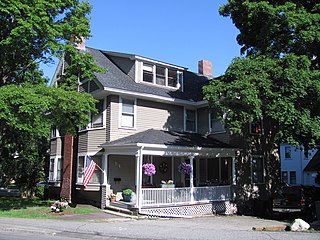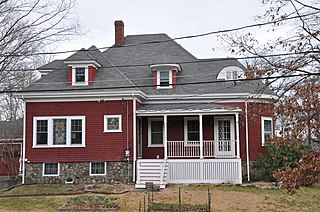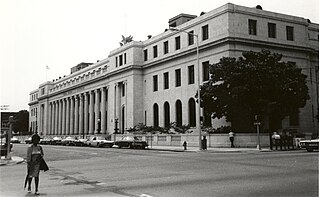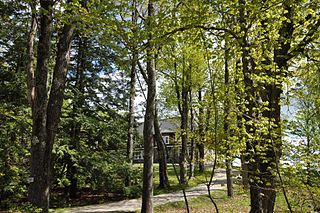
The George W. Smith House is a home in the Chicago suburb of Oak Park, Illinois, United States designed by American architect Frank Lloyd Wright in 1895. It was constructed in 1898 and occupied by a Marshall Field & Company salesman. The design elements were employed a decade later when Wright designed the Unity Temple in Oak Park. The house is listed as a contributing property to the Ridgeland-Oak Park Historic District which joined the National Register of Historic Places in December 1983.

The Col. Charles Codman Estate is a historic house on Bluff Point Drive in Barnstable, Massachusetts. Built in 1870, the house is a well-preserved example of a summer seaside resort house in Queen Anne/Shingle style. It was designed by Boston architect John Sturgis, and modified in the early 20th century, adding some Colonial Revival elements. The estate was listed on the National Register of Historic Places in March 1987, and it was included in the Cotuit Historic District in November 1987.

The Brande House is a historic house in Reading, Massachusetts. Built in 1895, the house is a distinctive local example of a Queen Anne Victorian with Shingle and Stick style features. It was listed on the National Register of Historic Places in 1984.

The Roberts House is a historic house at 59 Prospect Street in Reading, Massachusetts. The two-story house is basically Colonial Revival in character, but also exhibits Craftsman style features, including extended eaves with exposed rafter ends, stucco walls, and a chunky entrance portico. The window above the entrance is a Shingle style band of three casement windows, and there is a hip-roof dormer in the roof above. The house is one of Reading's better examples of Craftsman architecture, and was built in 1911, during a building boom on the town's west side.

The House at 2 Nichols Street in Wakefield, Massachusetts, is a well-preserved, architecturally eclectic house built in the 1890s. The 1+1⁄2-story frame house has elements of the Tudor Revival, Queen Anne, and Shingle styles, and is one of two identical houses built by local builder Berndt Heurlin. It has a hip roof, but transverse gables, one of which has a rounded bay, giving it a Queen Anne feel. The foundation exterior is fieldstone, and there are several stained glass windows.

Morton House, also known as Morton Mansion, is a historic home with Queen Anne style located at Webster Springs, Webster County, West Virginia that dates to 1912. It is a massive red brick dwelling set on a solid stone foundation, with a hipped roof and features a pair of 2+1⁄2-story turrets and each is topped with a conical shingled roof and capped with wooden finials. It also has a wraparound porch around 3/4 of the house.

Quogue Life-Saving Station is a historic U.S. government building at Quogue in Suffolk County, New York. It was built in 1912 by the United States Life-Saving Service in the Shingle Style, as a replacement for a deteriorating 1849-built station. It is a 1+1⁄2-story gable-roofed structure. It features a 4-story, wood-shingled tower topped by a hipped roof.

Masury Estate Ballroom is a historic ballroom located at Center Moriches in Suffolk County, New York. It was built about 1898 and was originally part of the Masury family estate. It is a long, rambling one story, Shingle Style wood-frame building. It has a "T shaped plan which contains the ballroom in the main upper portion and a bowling alley and billiards room in the long base. The building sits on a brick foundation and features a broad hip roof with hip roof dormers. The estate house was dismantled following the New England Hurricane of 1938, but the ballroom remained in use and is now owned by the Holiday Beach Property Owners Association.
Samson Fried Estate, also known as "Birch Hill," is a historic estate located at Severance in Essex County, New York. The estate has a Shingle Style main house, built as a summer residence in 1902, and nine contributing outbuildings. The main house is a large, two story rambling, roughly "L" shaped frame residence. It features hipped- and shed-roof dormers, four massive stone chimneys, second floor balconies, and a third story widow's walk. There is also a wide verandah around three sides of the house. The contributing buildings and structures include a garage, barn, hen house, tennis court, guest cottage, ice house, and well.

St. Paul's Episcopal Church is a parish church in the Diocese of Iowa. The church is located in Harlan, Iowa, United States. It has been listed on the National Register of Historic Places in 1978.

The Robert S. Vance Federal Building and United States Courthouse, previously known as the U.S. Post Office and Federal Building & Courthouse, is located at 1800 5th Avenue North in Birmingham, Alabama. The Beaux-Arts-style building was constructed in 1921. It served historically as a courthouse of the United States District Court for the Northern District of Alabama, and as a post office. It was listed on the National Register of Historic Places on June 3, 1976. It is still in use by the U.S. Bankruptcy Court for the Northern District of Alabama.

The I. Edward Templeton House is a historic building located in the central part of Davenport, Iowa, United States. It has been listed on the National Register of Historic Places since 1983.

The Charles S. Simpson House is a historic building located on the east side of Davenport, Iowa, United States. It has been listed on the National Register of Historic Places since 1983.

The William Holbrook House is a historic building located on the east side of Davenport, Iowa, United States. William Holbrook was a furniture and carpeting dealer. He was the first person to occupy this house. The 2½-story house features an irregular plan with several projecting pavilions, hipped roof, and the corner tower are typical of the Queen Anne style. What sets this house apart in Davenport is the exterior embellishments found in the clapboard siding, the millwork on the porch, and shingling typical of the Shingle Style. While these are not unusual in the Queen Anne style many have been re-sided in subsequent years, which makes this one stand out. The house has been listed on the National Register of Historic Places since 1984.

The Mason House is a historic house on Snow Hill Road in Dublin, New Hampshire. Built in 1888, it is a fine example of Shingle style architecture, with elements of the Richardsonian Romanesque inspired by architect Alexander Wadsworth Longfellow's mentor H. H. Richardson. The house was listed on the National Register of Historic Places in 1983.

The Nichols Memorial Library is a historic library building on Main Street in Kingston, New Hampshire, United States. Built in 1898, it is distinctive statewide as the only local library building exhibiting Shingle style and Richardsonian Romanesque features. It was used as the town library until 2012, and now houses the town's research collection and archives. The building was listed on the National Register of Historic Places in 1981.

The Hundley House is a historic residence in Huntsville, Alabama. The house was built in 1900 by Oscar Richard Hundley, a lawyer who served as City Attorney, State Representative, State Senator, and was appointed a judge to the United States District Court for the Northern District of Alabama. Soon after, he built three rental houses, two directly behind his house and one a block away. Hundley left Huntsville for Birmingham in 1909 and the house was later used as a funeral home and offices.

The Commerce Street Residential Historic District is a historic district in Greenville, Alabama. The district consists of four houses along Commerce Street, constructed between 1846 and 1895. They represent the final and last remaining residential construction on the town's main street.
Grouselands, also known more recently as the Waterman Farm, is a historic farm and country estate on McDowell Road in Danville, Vermont. The main house is a distinctive and rare example of Shingle style architecture in northern Vermont, and is the product of a major redesign of an Italianate farmhouse built in the 1860s. The house and immediate surrounding outbuildings were listed on the National Register of Historic Places in 1983.
The Pinehurst Historic District in Tuscaloosa, Alabama is a residential historic district which was listed on the National Register of Historic Places in 1986. The listing included 17 contributing buildings and nine non-contributing ones.


















